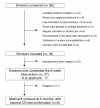A pilot study combining individual-based smoking cessation counseling, pharmacotherapy, and dental hygiene intervention
- PMID: 20565724
- PMCID: PMC2894778
- DOI: 10.1186/1471-2458-10-348
A pilot study combining individual-based smoking cessation counseling, pharmacotherapy, and dental hygiene intervention
Abstract
Background: Dentists are in a unique position to advise smokers to quit by providing effective counseling on the various aspects of tobacco-induced diseases. The present study assessed the feasibility and acceptability of integrating dentists in a medical smoking cessation intervention.
Methods: Smokers willing to quit underwent an 8-week smoking cessation intervention combining individual-based counseling and nicotine replacement therapy and/or bupropion, provided by a general internist. In addition, a dentist performed a dental exam, followed by an oral hygiene treatment and gave information about chronic effects of smoking on oral health. Outcomes were acceptability, global satisfaction of the dentist's intervention, and smoking abstinence at 6-month.
Results: 39 adult smokers were included, and 27 (69%) completed the study. Global acceptability of the dental intervention was very high (94% yes, 6% mostly yes). Annoyances at the dental exam were described as acceptable by participants (61% yes, 23% mostly yes, 6%, mostly no, 10% no). Participants provided very positive qualitative comments about the dentist counseling, the oral exam, and the resulting motivational effect, emphasizing the feeling of oral cleanliness and health that encouraged smoking abstinence. At the end of the intervention (week 8), 17 (44%) participants reported smoking abstinence. After 6 months, 6 (15%, 95% CI 3.5 to 27.2) reported a confirmed continuous smoking abstinence.
Discussion: We explored a new multi-disciplinary approach to smoking cessation, which included medical and dental interventions. Despite the small sample size and non-controlled study design, the observed rate was similar to that found in standard medical care. In terms of acceptability and feasibility, our results support further investigations in this field.
Trial registration number: ISRCTN67470159.
Figures
Similar articles
-
Interventions for tobacco cessation delivered by dental professionals.Cochrane Database Syst Rev. 2021 Feb 19;2(2):CD005084. doi: 10.1002/14651858.CD005084.pub4. Cochrane Database Syst Rev. 2021. PMID: 33605440 Free PMC article.
-
A review of the efficacy of smoking-cessation pharmacotherapies in nonwhite populations.Clin Ther. 2008 May;30(5):800-12. doi: 10.1016/j.clinthera.2008.05.010. Clin Ther. 2008. PMID: 18555928 Review.
-
Sustained care intervention and postdischarge smoking cessation among hospitalized adults: a randomized clinical trial.JAMA. 2014 Aug 20;312(7):719-28. doi: 10.1001/jama.2014.9237. JAMA. 2014. PMID: 25138333 Free PMC article. Clinical Trial.
-
Effect of varying levels of disease management on smoking cessation: a randomized trial.Ann Intern Med. 2009 Apr 7;150(7):437-46. doi: 10.7326/0003-4819-150-7-200904070-00003. Ann Intern Med. 2009. PMID: 19349629 Free PMC article. Clinical Trial.
-
[Effectiveness of bupropion and counseling for smoking cessation].Zhonghua Yu Fang Yi Xue Za Zhi. 2016 Jul 6;50(7):640-4. doi: 10.3760/cma.j.issn.0253-9624.2016.07.015. Zhonghua Yu Fang Yi Xue Za Zhi. 2016. PMID: 27412843 Chinese.
Cited by
-
Interventions for tobacco cessation delivered by dental professionals.Cochrane Database Syst Rev. 2021 Feb 19;2(2):CD005084. doi: 10.1002/14651858.CD005084.pub4. Cochrane Database Syst Rev. 2021. PMID: 33605440 Free PMC article.
-
Cognitive Behavioural Therapy versus Basic Health Education for Tobacco Cessation among Tobacco Users: A Randomized Clinical Trail.J Clin Diagn Res. 2014 Apr;8(4):ZC47-9. doi: 10.7860/JCDR/2014/8015.4279. Epub 2014 Apr 15. J Clin Diagn Res. 2014. PMID: 24959516 Free PMC article.
-
Identifying Behavior Change Techniques Used in Tobacco Cessation Interventions by Oral Health Professionals and Their Relation to Intervention Effects-A Review of the Scientific Literature.Int J Environ Res Public Health. 2021 Jul 13;18(14):7481. doi: 10.3390/ijerph18147481. Int J Environ Res Public Health. 2021. PMID: 34299931 Free PMC article. Review.
-
Health professional's perceptions of and potential barriers to smoking cessation care: a survey study at a dental school hospital in Japan.BMC Res Notes. 2010 Dec 7;3:329. doi: 10.1186/1756-0500-3-329. BMC Res Notes. 2010. PMID: 21138553 Free PMC article.
-
Process evaluation of a pragmatic feasibility trial on smokeless tobacco cessation intervention delivered in dental hospitals.BMC Public Health. 2024 May 16;24(1):1327. doi: 10.1186/s12889-024-18821-2. BMC Public Health. 2024. PMID: 38755594 Free PMC article. Clinical Trial.
References
Publication types
MeSH terms
Substances
Associated data
LinkOut - more resources
Full Text Sources
Medical



